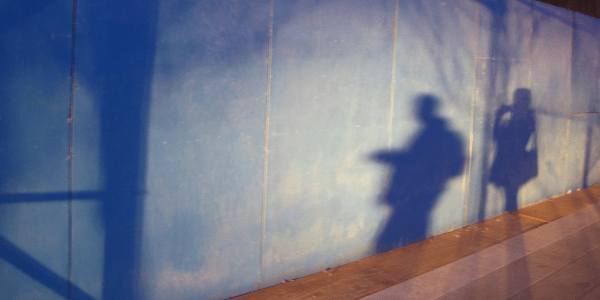What’s in the darkness
Must be revealed to light.Bob Marley, “Pass It On”1
For many years I have been doing shadow work, dipping into my own darkness in order to reveal what is found there and bring it into the light. A recovering addict with 28 plus years clean, I have danced with my dark shadow physically, mentally, emotionally, and spiritually. Recovery is a long, on-going process, one that draws on many supports, tools and helpers.
The more I learned, the more I understood the need to know my shadow. I wanted to understand what made me an addict, and how I can be more conscious of these parts of myself, so that I am less susceptible to slipping back into addiction in the future.
What is the shadow?
Two early pioneers in psychology and psychiatry, Sigmund Freud and Carl Jung, used the term “shadow” to mean aspects of ourselves that lay hidden from our conscious mind. Whether it is the long term effects of trauma or abuse, epi-genetics passed down through our biological inheritance, the collective subconscious of the human race that is contained within each of us, or the dark matter of our daily lives that gets pushed down, compartmentalized and forgotten, our “shadow” is the part of the psyche that we can’t consciously identify, and don’t understand. Yet we act it out.
Whether he was studying astrology, exploring archetypes or developing techniques to dialogue with the shadow, Carl Jung wrote about the shadow and introduced many techniques for exploring it.2
The shadow personifies everything that the subject refuses to acknowledge about himself [sic] and yet is always thrusting itself upon him directly or indirectly – for instance, inferior traits of character and other incompatible tendencies. […]
the shadow is that hidden, repressed, for the most part inferior and guilt-laden personality whose ultimate ramifications reach back into the realm of our animal ancestors and so comprise the whole historical aspect of the unconscious.
Another key concept used to understand how the shadow appears came from Sigmund Freud. He claimed “not only do we each have a ‘shadow’ self, but most people avoid confronting their own shadow within themselves, and unconsciously ‘project’ it onto others around them.”3

Illuminating the shadow
Not to be undertaken lightly, early shadow work is something that is often best done with the help of a therapist, guide, or counsellor because of the volatility of stored emotion that may arise, and the need to work through it in a safe and healing manner. Thankfully, Jung also stated that the shadow “does not consist only of morally reprehensible tendencies, but also displays a number of good qualities, such as normal instincts, appropriate reactions, realistic insights, creative impulses, etc.”4 It is possible that in the process of illuminating the shadow, positive aspects of character may also be revealed. While uncovering anger, fear, and obsessions, we may also discover we possess strength, resilience, tenacity, and endurance.
My own work with my shadow began in early recovery. Without the use of drugs to repress memories and the effects of post-traumatic stress, I found myself often overwhelmed with rage, anxiety, and deep sadness without fully understanding their source. Without an understanding of the human psyche and how we repress painful past memories, and ultimately add to our shadow selves, I though instead that I was going crazy. Without the mood and mind-altering effects of drugs, I was flooded with images and voices that I was unable to process.
My journey since then has been a long, enlightening, and revealing process, illuminating my shadow. I am learning about my early childhood life, the compounded family dynamics, and historical traumas which ultimately led me to addiction.
I have utilized a multitude of tools and helpers: self-help groups, a sponsor, group therapy, individual counselling, step-work, journalling, and meditation to help me come to know my shadow. I have benefited from a 30-day rehab program, healing retreats, somatic therapy release work, and building therapeutic relationships.
Related: Trauma-informed meditation: Processing the past, by Chrysanthemum White Alder
Related: 8 swords and no hands, by Xenia
Related: Mental health and magical practice: Learning to know thyself, by Chrysanthemum White Alder

Know your triggers
One of the most helpful techniques I have used is to start to notice when I am triggered, and begin to keep a list of what those triggers are. Triggers can be general, or very specific. Mine is a long list and includes the smell of alcohol on someones breath, loud voices, other peoples anger and what I call “white van PTSD.” Every time I see a white van on the road I am triggered into a state of fear and dread.
Beginning to recognize triggers, and my unconscious reaction to them, helped me recognize the presence of my shadow. By making a list of triggers I am able to bring the shadow material to my conscious awareness, so now when I see a white van and my heart starts racing, and I am suddenly terrified, my conscious brain kicks in and says: “Hey, I’m experiencing white van PTSD.” Naming the triggers has helped me to be conscious of them, and to recognize in the moment when I am triggered.
Reset buttons
The other list I keep in my notebook is a list of “reset buttons.” Like a button that resets an engine or operating system after system failure, these reset buttons are things or activities that can help me to literally reset myself after being triggered. My list includes a hot cup of tea, talking with one of my supportive allies in healing, having a bath or shower and submerging the top of my head (the crown chakra). These always help me to reset, move out of my shadow reaction, and return to the present time and have the ability to respond consciously to what arises.
With the continuing evolution of psychology and psychiatry, and ongoing neuropsychological research, there are more and varied resources available for doing shadow work and healing.
While many of these supportive methodologies fall within the medical realm, I have also delved widely into magical techniques with great success, benefiting from: divination, scrying, dreamwork and spell-casting; using ritual to ground, centre, protect and heal; trauma-informed yoga, breathwork, and meditation.
Related: Connected breathwork and subtle energy, by David Lee
Related: Meditation: Four techniques to get you started, by Mercury
Related: How to cast a circle anytime, anywhere Triskelion
Enlightenment
As with all healing, there is no quick fix for the shadow. The human psyche is vast and complex, and research reveals new understandings of the psyche, daily. Understanding that we each have a shadow, and becoming aware of how your shadow presents itself in your life is great groundwork. Being curious about how you project your shadow is also revealing.
If you feel compelled to do shadow work, to begin to know the parts of you that you are unconscious of, go gently. Know that you are not alone. There are many, many great resources and tools, both psychological and magical, that will help you to dance with your shadow, and reveal it to light. Approach the process slowly, steadily, and with great self-compassion.
Image credits: fiction of reality, Dani_B_Photo, Massimiliano
- Bob Marley and the Wailers, Burnin’, Island Records, 1973. [↩]
- Carl Jung, The Archetypes and the Collective Unconscious: Collected Writings, Volume 9 (Princeton: Princeton University Press, 1963), 284. [↩]
- Psychological Projection: Dealing with undesirable emotions, Everyday Health, 15 November 2017. [↩]
- Jung, Archetypes and the Collective Unconscious, 284. [↩]









